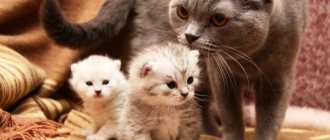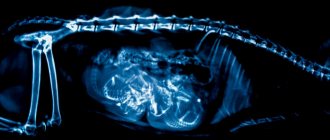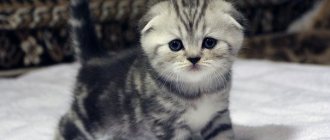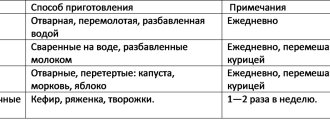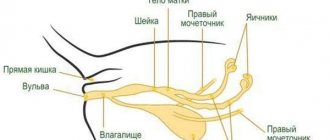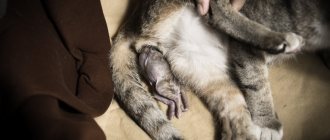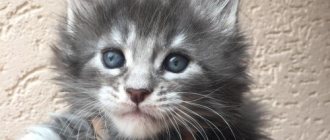Bearing and giving birth to kittens is an important stage in the life of both the cat and its owner. In order for everything to go as comfortably as possible and without harm to the expectant mother, you should calculate the birth date of the babies in advance.
Our online cat pregnancy and birth calculator will help with this. You will no longer have to get confused with notes on paper and make notes on the calendar. With our calculator you will definitely not make a mistake and will not miss a single detail.
How to determine if a cat is pregnant
If the owners consciously engaged in breeding, then they will not have problems determining pregnancy in the early stages. What you should pay attention to:
- two weeks after mating, the cat’s appetite increases;
- gradual weight gain occurs;
- nipples become darker and increase in size;
- toxicosis is rare, but it also happens. The pet may begin to vomit and have diarrhea;
- more aggressive behavior.
Pregnancy is a crucial period in the life of an animal
For your information! If a cat and a pregnant cat live together, the male may begin to show additional signs of attention to his chosen one and constantly protect her.
Stages
British cats are pregnant for just over two months. Bearing kittens is divided into several stages. For simplicity, we divide pregnancy into three stages:
- Beginning of pregnancy. The first stage lasts up to 25 days. The nipples noticeably turn pink, the belly increases slightly, becomes rounded and flexible. After 14 days, the fruits increase by about a centimeter. Limbs gradually form, internal organs begin to form. The cat eats abundantly, sleeps more often, and begins to look closely at the place where the future birth will take place.
- Mid-pregnancy. The second stage allows you to determine pregnancy with the naked eye at home. British cats are gentle and vulnerable animals; pregnancy takes a lot of strength and energy, so it would be a good idea to make an appointment with a specialist. Of course, in most cases the cat is able to give birth on her own, but a little safety net won’t hurt.
- At this stage, the brain, bone tissue (at first in the form of cartilage), muscle tissue, and the makings of the genitourinary system are actively formed. Claws are formed, the fetus vaguely resembles a kitten. The stage lasts on average 7-12 days. By the end of the trimester, kittens reach a size of 3 cm.
- End of pregnancy (preparation for childbirth). The “interesting” situation is entering its final phase. Due to the large belly (depending on the number of kittens), it is uncomfortable for the cat to walk and lick itself. Much at the third stage depends on the owner. From the attention and guessing of a silent and sometimes overly noisy British cat.
- The owner must make sure that the pet has enough food and clean fresh water, and a place for birth is equipped (even if it is a simple cardboard box). You can even turn it into a comfortable place to relax. In addition, at first, the kittens will live near the cat and begin to explore the outside world when they grow up a little. Without supervision, even a small apartment is fraught with many dangers for newborns.
By 40-45 days, kittens develop hair and an individual color. The third stage should be fully controlled either by a specialist or by family members. The cat may experience panic, depression, lethargy, and go to the toilet in the wrong place. If you touch the belly of a British cat, you can feel the movement of newborns.
How long does a cat's pregnancy last?
A cat's pregnancy lasts on average from 10 to 17 weeks. However, these indicators are relative, since animals, just like people, can bear a fetus longer or, conversely, less.
How long does pregnancy last in cats: duration
However, prematurity and late labor can lead to unpleasant consequences. If kittens are born earlier than 10 weeks, there is a high probability that they will not be viable. If the gestation period exceeds 17 weeks, this may already threaten the health of the cat herself. In this case, she may need medical assistance to give birth safely.
It should be remembered that the future furry mother also requires a medical examination during pregnancy:
- to assess the general physical condition of the animal;
- calculate the cat's pregnancy calendar;
- find out the number of kittens;
- determine whether there is a need for medical assistance during childbirth. In rare cases, a cesarean section is even prescribed.
Important! If the owner has the opportunity, it will be better if the entire pregnancy period takes place under the supervision of a specialist, just like in humans.
Ultrasound
Why is it important to calculate your due date in advance?
During the period of bearing offspring, the cat needs special attention and care. And when the time comes to give birth, the owner must be nearby to provide assistance if necessary. This is especially necessary for purebred animals, which often experience complications.
Many owners take special vacations so that the expectant mother is not left alone. Others make an appointment at the veterinary clinic for the expected date of birth, especially if the pet has health problems. In any case, knowing the approximate date of such a significant event is extremely important.
How to determine the gestational age of a cat
A gradually increasing belly makes many owners nervous and worried. For greater peace of mind, you can keep a calendar until your cat gives birth. However, this method is suitable for those who approximately or exactly know the moment of conception.
Discharge from a pregnant cat: bloody, yellow
Pregnancy is determined and significantly manifests itself already on days 16-18. The belly gradually grows, the nipples swell and become darker. The expectant mother's appetite increases, which undoubtedly affects her weight.
However, these are only visual signs that can tell the owner little. A pregnancy calculator can help you determine when your cat will give birth. Such programs are available on the Internet and are quite easy to use. However, the owner will also need information about the day of mating.
Important! If there is no information about conception, only a veterinarian can tell you a more precise date.
Postpartum rehabilitation
Let us dwell in more detail on the moment when the cat has already given birth, but for some reason cannot take care of the kittens, the owner must do the following:
- clean the kitten from postpartum film;
- place the kitten next to the mother;
- if necessary, carefully trim the umbilical cord at a distance of 4-5 centimeters from the navel;
- If necessary, wipe the kitten with a dry towel.
If the kitten does not move, you should carefully take it into your palm and shake it several times. Perhaps the mouth and lungs are filled with birth fluid. If this is the first kitten, you can put it aside on a dry diaper to protect it from the contractions of the British cat. The interval between the birth of kittens ranges from 10 minutes to an hour.
When the birth is completed, the family should be placed in a specially prepared place or left in a box. Provide food and water to help the cat recover after giving birth. A British cat may have discharge for several days. As a rule, this is a phenomenon of one or two days. If the process is delayed, you should consult a doctor.
For diarrhea, you should feed with rice water and boiled water. Oatmeal and warm milk will help with constipation. Close attention, affection and understanding will help significantly ease the birth of a British cat and avoid any negative consequences. For example, a miscarriage, which can lead not only to the loss of offspring, but also to surgical intervention.
Useful materials:
- Cutaneous horn General description of the disease Cutaneous horn on the forehead or face (ICD 10 code - L57.0) -...
- The cat has cancer Stages of mammary gland cancer in cats Like in humans, cat mammary cancer has ...
- Itching and odorless discharge Main causesBefore considering the factors that provoke the appearance of discharge that has a sour odor, it is necessary to immediately note...
- Normal temperature in animals Normal temperature in different types of animals Veterinary services Day hospital for animals Veterinary certificates Vaccination…
Cat pregnancy calendar by week
How is toxoplasmosis transmitted from cat to person?
Fetal development stages are most often indicated in weeks, and in the early stages days are used. Below we take a closer look at intrauterine development from the very first days.
Development by week
First week (0-7 days)
The embryo's cells divide but move freely throughout the uterus. Attachment to the wall occurs only 7-10 days after conception. This process is called implantation and the countdown begins with it. The online cat birth calculator also takes this period into account.
Second-third week (8-21 days)
The placenta is forming. Already on the 15th day, its formation is completed, and it is able to nourish and protect the embryo. The size of the future kitten is still very small. Outwardly, it looks like the letter C, but even in this form you can find the outlines of the future head and tail.
For your information! At this time, the first signs of pregnancy appear in the cat. The expectant mother becomes more capricious, picky, and may hide for a long time in a quiet, dark place.
Fourth week (22-28 days)
The fertilized egg increases to a size of 15-20 mm. At the moment, the cat embryo is difficult to distinguish from other mammals. The gradual development of internal organs, including the brain and heart, begins.
Important! An ultrasound at this stage shows a heartbeat of about 230 beats/min.
By the end of the 28th day, the baby’s paws, pads, and claws begin to form. The cat's behavior does not change during this period. Toxicosis may occur.
Fifth-sixth week (29-42 days)
At 5-6 weeks, sensory organs gradually form. As you know, cats have well-developed hearing and a sense of balance. Also at this stage, gradual preparation for growing a mustache occurs, and soft claws appear.
At this same stage, the nervous system and muscles develop. The child begins to actively move and push the mother cat. Most experts are inclined to believe that at this time the formation of the psyche ends, so it is worth paying great attention to the psychological comfort of a pregnant cat.
Seventh-eighth week (43-56 days)
The bones and spine are clearly visible on the x-ray. The fur is already fully formed. In general, on the 50th day, kittens are ready to be born, but this point also depends on the breed.
For example, the straight-eared British cat, Bengal, Maine Coon, and Scottish Fold grow a little slower than other members of the cat family and, accordingly, live longer. For this reason, you should not fit the pregnancy periods of sphinxes and “British” women into a single framework.
The ninth week is a harbinger of labor
The mother cat gradually begins to prepare for childbirth. The body shows the first symptoms, such as test contractions. The owner should carefully monitor the behavior, since in the prenatal state the pet is looking for a secluded place. It is also important not to create stressful situations for your pet and to feed it well.
Developed fetus
Week 10 (day 64 onwards)
By this time, those kittens that belong to the late breeds are already born. The cat's behavior during this period becomes calmer. The expectant mother expects the birth of her babies in a certain place, almost without leaving her bed.
Owners can purchase or make a special house for a cat. The main thing is that it is warm and closed from prying eyes.
Fetus at 13 weeks of gestation
For most cats that do not belong to certain breeds, the 13th week is already exceeding the norm. Further gestation can lead to the development of an overly large fetus, which can cause harm during childbirth.
Important! If the period has clearly exceeded the established period, it is better to seek help from a doctor.
Features of care and contraindications during this period
A pregnant cat requires the most careful handling. It is better not to pick her up; at least, hold her under her butt and breasts without touching her stomach. Medicines (even mild ones) can only be given as prescribed by a veterinarian. Worms cannot be removed at this time.
Related article: What you need to know about mating Scottish Fold cats
It is not recommended to let your cat outside to avoid injury and infection. It is important to protect her from drafts and hypothermia, to ensure that she does not climb onto high furniture, much less jump from there. Loud sharp sounds, turmoil or fright can cause a miscarriage, and if the term is late, on the contrary, a delay in labor. At this time, it is better to isolate the animal from small children.
Please note that a pregnant cat may go into heat. This happens due to living together with a cat or hormonal imbalance. At this time, re-fertilization is possible, but most often it ends in the death of either the “younger” litter or all the kittens. In rare cases, a cat gives birth to both “generations” in succession, but in this case she most often does not have enough milk. Therefore, if you have a couple of animals, it is better to keep your Scottish cat separately during pregnancy.
Another important question is what to feed a pregnant cat. At this time, you cannot transfer the animal from natural feed to industrial feed, and vice versa. Such a change in diet in itself is a burden for the body. When eating natural food, it is important that the diet contains a lot of protein: veal, dairy products, fish, eggs. Vegetables are also important. If you prefer to feed your pet commercial food, you need to choose a type specifically for pregnant and lactating cats.
Nutrition should include a full range of vitamins and microelements. Calcium is especially important. A veterinarian should select nutritional supplements. In the first weeks, food volumes should remain the same, but for weakened animals they can be increased by 10–15%. Gradually, meals are made fractional; by the middle of pregnancy, the frequency of feeding should reach 4–5 times a day. Initially, small portions are gradually increased. By the end of the period they should have grown approximately 2 times.
Similar article: Choosing nicknames for girls and boys of Scottish Fold cats
For constipation, you can give your cat vegetable oil.
Routine ultrasound during pregnancy
A specialist can prescribe an ultrasound scan at almost any time during pregnancy if the animal’s condition is in doubt. In the early stages, the owner can contact the veterinarian to confirm or deny the presence of pregnancy.
Next, the development of the fetus is monitored and the number of future kittens is determined. In any case, a visit to the veterinary clinic is recommended both for preventive purposes and if you experience feelings of anxiety about the condition of your pet.
Scheduled ultrasound
How to prepare for childbirth?
When the due date approaches, you need to be prepared to help your cat. Usually animals cope on their own, but young ones who are becoming mothers for the first time can get confused.
What will be useful:
- Scissors for cutting the umbilical cord.
- Zelenka or iodine for treating the umbilical cord.
- The diaper is old, for drying kittens.
- A small syringe for removing mucus from the nose of kittens.
You need to find out the veterinarian’s phone number in advance and arrange a possible visit to your home.
Puzatik
A place for the cat and future kittens should also be prepared: bedding, a dark place without drafts.
Caring for a pregnant cat
After giving birth, the cat does not require any special care. After making sure that everything is fine with the pet and newborn kittens, the person should leave them alone and quiet. The female is able to chew off the umbilical cord on her own and lick her babies.
The only important nuance regarding care is that in the future the bed will need to be changed periodically. And for a certain time, water and food (wet or easily digestible) should be kept next to the young mother.
For humans, cat birth is not something difficult or scary. In most cases, the animal itself knows what to do and how to behave. The main thing is to feed the pregnant cat well and provide her with peace.
Childbirth
You can notice that a cat is in labor by looking at its behavior. She gets excited, screams, and follows her owner. May often lick the genitals - this is a clear sign of impending labor.
Within 24 hours after contractions begin, the first kitten should appear. If this does not happen, you need to urgently take her to the veterinary clinic.
Scottish Fold cats usually give birth spontaneously. After the water breaks, contractions begin. The discharge may not be noticed because the animal will lick everything. Then he lies down on his side, looks at his stomach, and pushes. Cats give birth without sounds. As soon as the kitten appears, the mother immediately licks it, gnaws the umbilical cord, and eats the afterbirth. This is normal behavior for cats. The afterbirth eaten helps the uterus contract better.
Kids
If the cat is in no hurry to lick the newborn, you need to wipe it and cut the umbilical cord. Treat the umbilical wound with iodine or brilliant green. Remove mucus from the nose and mouth, and immediately put it on the cat so that he begins to suck. The kitten needs to receive colostrum in the first minutes of life, and this helps the cat to successfully give birth to the rest, since the uterus is stimulated and contracted.
When all the babies are born and licked, the cat calms down and takes a nap. And the kittens actively look for nipples and eat.
How to find out if a British woman is pregnant
If the British woman and her chosen one are healthy, and fertilization has occurred successfully, within one and a half to two weeks after mating the owner may notice the first signs of pregnancy:
- Possible toxicosis (not all cats have it) – the pet feels nauseous, its appetite is reduced;
- Change in the shade of the nipples (all or several) - they become distinctly pink;
- The cat tends to fall asleep - the pregnant pet will prefer solitude in a secluded corner to active games.
In the middle of pregnancy, the owner of a British cat will notice more obvious signs of an imminent addition to the mustachioed family:
- The cat's belly is rounded, which is noticeable to the naked eye;
- The animal's appetite increases;
- The nipples become swollen.
In the last 3 weeks before giving birth, the cat behaves like a real expectant mother:
- Relaxes a lot - saves strength before the birth of kittens;
- Looks for a “nest” - a corner for offspring, spends a lot of time there.
Immediately before giving birth (24-12 hours or less), the pet begins to produce milk, breathes frequently, meows anxiously, and licks the perineum. 2-3 hours before a joyful event or immediately before the birth itself, the cat’s water breaks - a gray-yellow liquid. Half an hour to an hour before the moment of birth, contractions begin.
How many kittens are born
The average number of babies at lambing is six.
A cat's heat lasts about a week, and during one pregnancy she often bears several babies from different fathers. Due to the special structure of the uterus, eggs can be fertilized by several males. Since the cat has 8 nipples, she can feed the kittens accordingly. But for a number of reasons there may be fewer or more fruits; generally, there are up to 6 babies in one litter. During the first pregnancy, there are usually 1-3 kittens in the cat’s belly; in subsequent births, the number increases and sometimes reaches 14. Reasons affecting the number of kittens:
- Nutrition and conditions of detention before mating.
- Animal weight. Large females rarely become pregnant.
- Genetic predisposition to overmature or to low-fertility pregnancy.
- Diseases of the genitourinary system.
- Cat sperm quality.
- Hormonal imbalance.
- Breed.


